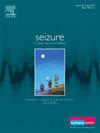小儿癫痫中手部姿势偏侧与定位价值的评价。
IF 2.7
3区 医学
Q2 CLINICAL NEUROLOGY
引用次数: 0
摘要
前言:确定癫痫区是选择癫痫手术患者和了解癫痫发病病理生理的必要条件。本研究的目的是评估垂直手部姿势在儿童定位和偏侧价值中的作用。材料和方法:利用2013年至2022年加齐大学视频脑电图监测单元(VEMU)的长期视频脑电图记录,对628名个体进行回顾性评估。在56例患者中发现不同的手部姿势。评估这些患者手部姿势的定位和偏侧价值。结果:共分析56例患者的91次癫痫发作,手部姿势分为拳、拇指上拳、扇形、握、食指指、钳抓。拳头姿势在额叶发作中最常见,而TUF在颞叶发作中占主导地位。范宁主要与全身性癫痫发作有关。侧位分析显示,同侧体位在额叶癫痫发作中更常见,而对侧体位在颞叶癫痫发作中更常见(p < 0.05)。结论:总而言之,手势可以作为一种简单易懂的工具,用于识别儿童癫痫发作区域,特别是在资源有限的情况下。符号学分类在视频脑电信号的解释中起着至关重要的作用。准确识别符号学表现有助于及时转诊疑似耐药局灶性癫痫患者进行术前评估。本文章由计算机程序翻译,如有差异,请以英文原文为准。
Evaluation of lateralization and localization value of hand postures in Pediatric Epilepsy
Introduction
Identifying epileptogenic zone is essential for selecting patients for epilepsy surgery and understanding seizure pathophysiology. This study aimed to evaluate the role of ictal hand postures in localization and lateralization value in children.
Material and methods
We conducted a retrospective evaluation of 628 individuals utilizing long-term video EEG recordings of Gazi University Video EEG Monitoring Unit (VEMU) between 2013 and 2022. Distinct hand postures were identified in fifty-six patients. The localization and lateralization value of the hand postures identified in these patients were assessed.
Results
A total of 91 seizures from 56 patients were analyzed, and hand postures were categorized as fist, thumb upside fist (TUF), fanning, holding, index-finger pointing (IFP), and pincer grasp. Fist posture was most frequently observed in frontal lobe seizures, while TUF was dominant in temporal lobe seizures. Fanning was primarily associated with generalized seizures. Lateralization analysis revealed that ipsilateral postures were more common in frontal lobe seizures, whereas contralateral postures were prevalent in temporal lobe seizures (p < 0.05).
Conclusion
In conclusion, ictal hand postures may serve as a straightforward and accessible tool for identifying seizure onset zones in children, especially in resource-limited settings. Semiological classification plays a crucial role in the interpretation of video EEG. Accurate identification of semiological manifestations can facilitate timely referral of patients with suspected drug-resistant focal epilepsy for presurgical evaluation.
求助全文
通过发布文献求助,成功后即可免费获取论文全文。
去求助
来源期刊

Seizure-European Journal of Epilepsy
医学-临床神经学
CiteScore
5.60
自引率
6.70%
发文量
231
审稿时长
34 days
期刊介绍:
Seizure - European Journal of Epilepsy is an international journal owned by Epilepsy Action (the largest member led epilepsy organisation in the UK). It provides a forum for papers on all topics related to epilepsy and seizure disorders.
 求助内容:
求助内容: 应助结果提醒方式:
应助结果提醒方式:


